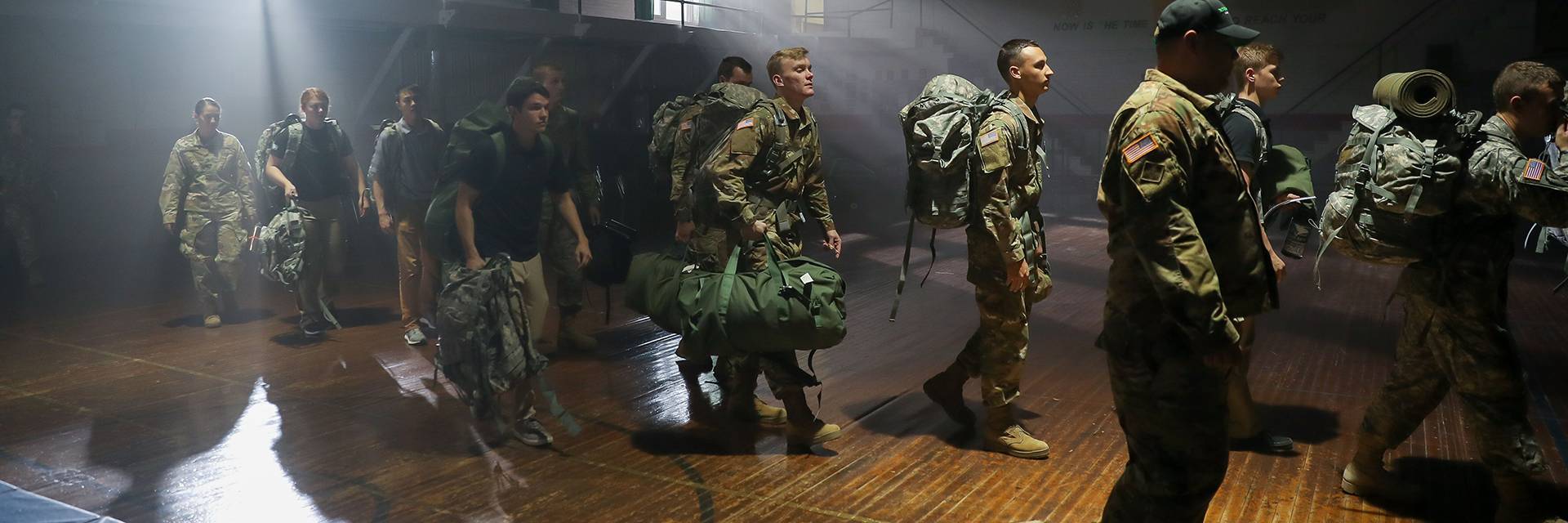
Cadet Training
The Army ROTC program wants to give its cadets the best experiences available to help for them as future leaders in the Army.
Cadets learn from Field Training exercises (FTX) and leadership labs, as well as special training like Airborne and Air Assault School. Cadets learn many valuable skills from these training events and will use them on a daily basis while serving in the United States Army.
Training Events
FTXs give cadets the opportunity to have hands on training related to the Army. Cadets will learn rifle marksmanship, grenade basics, and team leadership through specially designed obstacle courses. They will also experience squad based missions in a natural environment and learn to navigate the land using a map and compass. FTXs is used to build the cadets knowledge and prepare them for future training.
Leadership labs are held once a week (usually Thursdays) throughout the semester and are used to help build and retain the cadets’ knowledge of Army tasks and skills. The cadets use lab to perfect skills like preparing and briefing missions, as well as executing these missions. Cadets are also evaluated by the senior leadership, so they can learn from the mistakes they make and better themselves for the next lab. Lab ultimately helps prepare every cadet for the FTXs and the Cadet Leadership Course (CLC).
Every contracted Army ROTC Cadet who enters into the Advanced Course attends the Advanced Camp (AC). It's a four-week summer course that trains Cadets to Army standards, develop leadership, and evaluate officer potential. Additionally, AC meets the pre-commissioning summer training requirement. AC is the most significant training evaluation event in ROTC. Training is complex, challenging, and rigorous and is conducted in a stressful training environment. This course normally takes place between your junior and senior years of college, and is conducted at Fort Knox, KY.
Basic Camp (BC) is a four weeks summer training event consisting of a wide range of training events designed to develop/assess leadership and officer potential and potentially qualify Cadets for contracting.This is conducted at Fort Knox, KY.BC is rigorous and demanding, both mentally and physically, and will test intelligence, ingenuity and stamina.BC training events provide a new perspective on an individual's ability to perform challenging tasks and to make sound decisions in demanding situations. Once completed, it would have accomplished the same training (tasks) to the same standards required for the on-campus program during Military Science I & II Course (Basic Course). This training is conducted at Fort Knox, KY.
The Cadet Troop Leader Training (CTLT) track provides Cadets the opportunity to experience leadership in Army Table of Organization and equipment (TO&E) units over a three to four week period. Cadets serve in Lieutenant level leadership positions in active duty units. Platoon Leader positions have a 3-4 week duration depending on the hosting unit and location. Assignments include units that are located CONUS and OCONUS. Cadets are assigned a unit mentor, and are provided on-post lodging and meals via a dining facility. This program is exclusively designed for MSIII Cadets before and after completion of CLC.
The Cultural Understanding and Leadership Program (CULP) program is a Cadet Professional Development Training (CPDT) designed to develop future leaders who are culturally astute, having gained experience to prepare them for their first deployment in a multi-national environment. Now more than ever, cultural awareness training is a vital component to the ROTC curriculum. Overseas immersions help educate future leaders in ways the classroom cannot. Cadets now have the opportunity to compete for immersion in more than 40 countries. These opportunities expose them to everyday life in different cultures and intensifies language study, which helps produce commissioned officers who possess the right blend of language and cultural skills required to support global operations in the 21st Century. Participants experience up to three different venues during immersion, including humanitarian service, host nation military-to-military contact and educate on the social, cultural and historical aspects of the country.
The primary task it to teach Cadets how to safely conduct static line parachuting. PT is included to indoctrinate soldiers into the Army lifestyle and to ensure they are mentally and physically prepared for the rigors of daily Airborne training. The three week course consists of a ground phase, a tower phase, and jump week. Cadets will learn to properly jump from the aircraft with full military equipment and land on the ground successfully. During Jump Week, Cadets must successfully complete five parachute jumps from a C-130 or C-141 aircraft and will be awarded the Airborne badge, which they can wear on their uniform for the rest of their Army career.
Like Airborne School, Air Assault is a specialized form of training cadets can take part in. At Air Assault, cadets learn to rappel, fast rope, and sling load equipment to helicopters. The course consists of a admin day, a Zero day and 10 days of instruction broken down into three phases: 1) Combat Air Assault; 2) Sling Load Operations and 3) Rappelling Phase. Students must complete a 12 mile foot march with prescribed equipment weighing between 25-30 pounds in three hours or less. Upon successful completion of all required tasks, cadets will be awarded the Air Assault badge, which like the Airborne badge, can be worn on their uniform for their entire Army career.